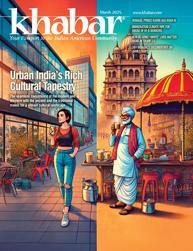Talk Time: Media Mogul

Raju Narisetti has had stints at publications like The Wall Street Journal and The Washington Post—and he was, until recently, the CEO of Gizmodo Media Group. Narisetti, who has degrees in economics and business management, founded Mint, India’s second-largest business newspaper by circulation. How does he see today’s media landscape?
What is the challenge of getting eyeballs with multiple outlets competing for attention?
On the one hand, thanks to digital technologies, there has never been a larger current audience and potential audience in the history of media, since the invention of the Gutenberg Press.
But the flip side is that audiences can be rather promis-cuous and “travel” to any media outlet they want or, better yet, have any journalism and storytelling travel to where they already are. This means the focus has to on both attracting and then retaining audiences and has forced media companies to be on their toes.
At the end of the day, great, honest, accurate and engaging journalism still has the best potential to succeed, but newsrooms now need to spend a lot more energy on getting that in front of audiences—unlike in the newspaper era when readers were a lot more “captive” because of where they lived.
How do media groups stay vital and combat the growing negative narrative of “fake news?”
By creating meaningful differentiation with our journalism, rather than better sameness that many seem to practice. And by practicing sound journalistic processes. We owe it to our audiences to be accurate and transparent. That doesn’t mean we won’t make the occasional mistake, given the nature of how journalism works. But it shouldn’t happen because we didn’t follow our own internal standards. And we should learn from our mistakes, because there is no extra education from the second kick of the same mule.
Do you visit India often? What one thing have you noticed changing over the last ten years in the media landscape there?
In my previous role as Senior Vice President of Strategy for News Corp., I did visit India often in 2015-16 but I am afraid
I haven’t since taking on this new assignment. I have a lot of very dear friends in Hyderabad, where I grew up, and elsewhere in India, but no immediate family there anymore.
As the founder of Mint, now India’s second-largest business newspaper by circulation, I remain very connected and interested, even if anecdotally, to Indian media. Between business and newsroom practices at its largest media companies and lack of any enforcement or policing of any standards by the industry itself, there is a growing malaise in India’s media. The current government, from everything I hear, has played a big role in muzzling honest debate and has cast a rather big shadow on the free press, despite the veneer of a thriving democracy and a “free” press. There is a lot of blame to go around including the fact that the vast majority of newsrooms have very little by way of leadership willing to stand up to pressure.
How has journalism changed even since when you first started in the field?
Immensely, even if the fundamentals of what constitutes good and compelling journalism remain at the core of today’s journalism. The biggest change is around how journalism is both created and consumed.
Looking into the crystal ball, with the First Amendment being so precarious, do you worry about the future?
I don’t worry about the future of journalism. I worry about the continuing search for sustainable business models to support great journalism. It remains a serious work-in-progress.
What advice would you give to desi kids who want to be like you?
Don’t be like me. Be yourself. When I first came to the U.S., back in 1990, there were a handful of journalists of Indian origin. Today, there are hundreds including in many major media companies and also in very senior roles. The [way forward] is there if you want to go down any path you choose.

Poornima Apte is a Boston-area freelance writer and editor. Learn more at WordCumulus.WordPress.com.
Enjoyed reading Khabar magazine? Subscribe to Khabar and get a full digital copy of this Indian-American community magazine.
blog comments powered by Disqus












